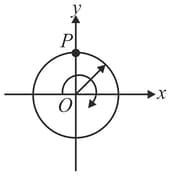Embibe Experts Solutions for Chapter: Circular Motion, Exercise 1: BEGINNER'S BOX - 1
Embibe Experts Physics Solutions for Exercise - Embibe Experts Solutions for Chapter: Circular Motion, Exercise 1: BEGINNER'S BOX - 1
Attempt the practice questions on Chapter 7: Circular Motion, Exercise 1: BEGINNER'S BOX - 1 with hints and solutions to strengthen your understanding. Beta Question Bank for Medical: Physics solutions are prepared by Experienced Embibe Experts.
Questions from Embibe Experts Solutions for Chapter: Circular Motion, Exercise 1: BEGINNER'S BOX - 1 with Hints & Solutions
A stone tied to the end of a long string is whirled in a horizontal circle with a constant speed. If the stone makes revolutions in , the magnitude of its acceleration is :
For a body in a circular motion with a constant angular velocity, the magnitude of the average acceleration over a period of half a revolution is.... times the magnitude of its instantaneous acceleration.
A ring rotates about axis as shown in figure. The plane of rotation is . At a certain instant the acceleration of a particle (shown in figure) on the ring is . Find the angular acceleration of the ring and its angular velocity at that instant. Radius of the ring is .

A disc rotates about a fixed axis. Its angular velocity varies with time according to the equation . Initially at its angular velocity is and angular position is ; at the instant , angular velocity is Determine angular position and angular acceleration when .
A wheel of radius is rotating at a constant angular acceleration of . Its initial angular speed is . What will be its angular speed and angular displacement at ?
A car has wheels of radius and is travelling at . Calculate the angular speed of the wheel.
A car has wheels of radius and is travelling at Calculate if the wheels describe revolutions before coming to rest with uniform acceleration. Find its angular acceleration.
A car has wheels of radius and is travelling at . Calculate if the wheels describe revolutions before coming to rest with a uniform acceleration the distance covered.
